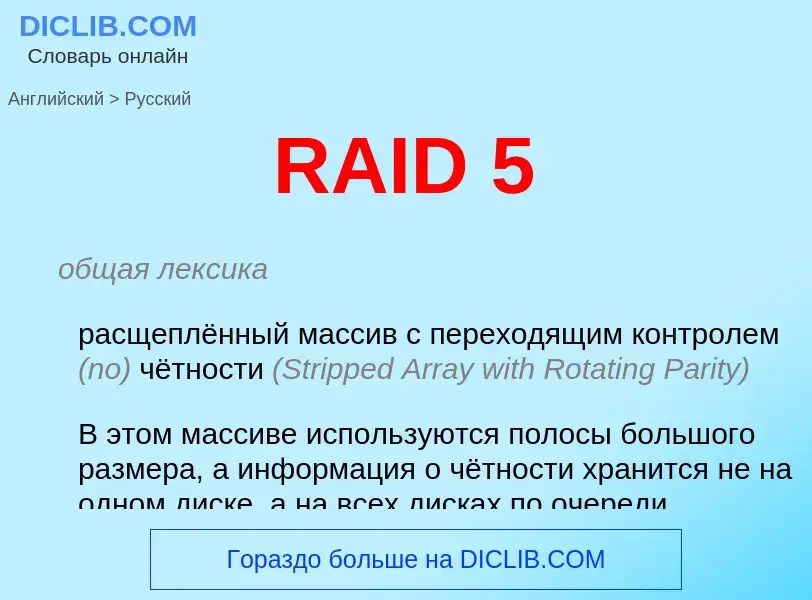Translation and analysis of words by ChatGPT artificial intelligence
On this page you can get a detailed analysis of a word or phrase, produced by the best artificial intelligence technology to date:
- how the word is used
- frequency of use
- it is used more often in oral or written speech
- word translation options
- usage examples (several phrases with translation)
- etymology
RAID 5 - translation to English
общая лексика
расщеплённый массив с переходящим контролем (по) чётности (Stripped Array with Rotating Parity)
В этом массиве используются полосы большого размера, а информация о чётности хранится не на одном диске, а на всех дисках по очереди. Операции записи обращаются к одному диску с данными и к другому диску с информацией о чётности. Область применения: надежные массивы большого объёма. Уровни RAID 0 - RAID 5 в конце 1997 г. RAID Advisory Board заменила тремя новыми классификациями: DTDS, FRDS, FTDS
Смотрите также
общая лексика
запись с расщеплением данных (Non-Redundant Stripped Array)
Этот уровень объединения дисков в массив определяет неизбыточную группу дисков (обычно три), на которые производится запись с использованием расщепления данных, что обеспечивает максимальную производительность дисковой подсистемы. Недостаток - чувствительность к надёжности отдельных дисков
Смотрите также
общая лексика
параллельный массив с контролем и исправлением ошибок (Parallel Array with ECC)
Смотрите также
Definition
Wikipedia
In computer storage, the standard RAID levels comprise a basic set of RAID ("redundant array of independent disks" or "redundant array of inexpensive disks") configurations that employ the techniques of striping, mirroring, or parity to create large reliable data stores from multiple general-purpose computer hard disk drives (HDDs). The most common types are RAID 0 (striping), RAID 1 (mirroring) and its variants, RAID 5 (distributed parity), and RAID 6 (dual parity). Multiple RAID levels can also be combined or nested, for instance RAID 10 (striping of mirrors) or RAID 01 (mirroring stripe sets). RAID levels and their associated data formats are standardized by the Storage Networking Industry Association (SNIA) in the Common RAID Disk Drive Format (DDF) standard. The numerical values only serve as identifiers and do not signify performance, reliability, generation, or any other metric.
While most RAID levels can provide good protection against and recovery from hardware defects or defective sectors/read errors (hard errors), they do not provide any protection against data loss due to catastrophic failures (fire, water) or soft errors such as user error, software malfunction, or malware infection. For valuable data, RAID is only one building block of a larger data loss prevention and recovery scheme – it cannot replace a backup plan.

